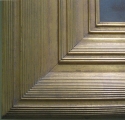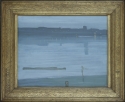The Paintings of James McNeill Whistler
YMSM 098
Symphony in Grey: Early Morning, Thames

Date
Symphony in Grey: Early Morning, Thames is signed and inscribed '71' and dates from 1871. 1

Symphony in Grey: Early Morning, Thames, Freer Gallery of Art
It was probably first exhibited in the following year, in the Fifth Exhibition of the Society of French Artists [Winter Exhibition], Deschamps Gallery, London, 1872 (cat. no. 122).
Images

Symphony in Grey: Early Morning, Thames, Freer Gallery of Art

Symphony in Grey: Early Morning, Thames, Freer Gallery of Art

Symphony in Grey: Early Morning, Thames, frame detail

Battersea Reach, Corcoran/National Gallery of Art, Washington DC
Subject
Titles
Several possible titles have been suggested:
- Probably 'Harmony in Grey' (1872, Deschamps). 2
- 'Symphony in Grey' (1904, ISSPG). 3
- 'Symphony in Grey - Early Morning, Thames' (1905, Buffalo Fine Arts Academy). 4
- 'Symphony in Grey: Early Morning, Thames' (1980, YMSM). 5
'Symphony in Grey: Early Morning, Thames' is the preferred title.
Description

Symphony in Grey: Early Morning, Thames, Freer Gallery of Art
An almost monochrome painting of the view across a broad river, in horizontal format. The foreshore runs at a slight angle upwards from lower left to right, the line of the water's edge broken only by the rectangular cartouche bearing Whistler's signature. On the far side are warehouses and factories, with two factory chimneys towards the right, reflected in the water. Towards the far side of the water, at left, there is a long, low barge or steamer with a single tall funnel, and behind it, to right, another long barge, possibly moored.
Site

Symphony in Grey: Early Morning, Thames, Freer Gallery of Art

Battersea Reach, Corcoran/National Gallery of Art
The same view of Battersea Reach is seen in Battersea Reach y045. The view is from in or near Whistler's house in Chelsea, looking south across the river Thames, in London.
Comments
Curry considered the restrained colour scheme and almost abstract, geometrical composition, with the butterfly on its rectangular field balancing the puff of smoke from the chimneys, as 'orientalizing elements.' He quotes Ernest Fenellosa, who wrote that Whistler's greys 'pulsate with imprisoned colours,' and who considered Whistler the only European artist to use grey as the basis of colour harmonies, as in the 'old Chinese school.' 6
Technique
Technique

Symphony in Grey: Early Morning, Thames, Freer Gallery of Art
It is thinly painted in shades of grey over a red ground on fine canvas, the grain of the canvas showing through the paint. The brushstrokes sweep straight across the canvas from left to right, conveying light and space, ripples and reflections. Although subdued in tone, and partly lost in the grey atmosphere, the details of buildings, chimneys and smoke on the south side of the river were painted very carefully with small brushes.
Conservation History
According to Freer Gallery files, the varnish was removed and the canvas relined in 1921; it was surfaced in 1933, and cleaned and surfaced in 1951.
Frame
- 1872: the style and whereabouts of the original frame are unknown.
- 1904: Grau-style, American.

Nocturne: Blue and Silver - Chelsea, Tate
Symphony in Grey: Early Morning, Thames was first exhibited in 1872 and may therefore have had a reeded cassetta painted frame similar to that on Nocturne: Blue and Silver - Chelsea y103, reproduced above, and Variations in Pink and Grey: Chelsea y105.

Symphony in Grey: Early Morning, Thames, Freer Gallery of Art

Symphony in Grey: Early Morning, Thames, frame detail
The current Grau-style frame probably dates from after 1904, when the painting was bought by C. L. Freer.
History
Provenance
- By 1904: Mrs Armitage (fl. 1904);
- 1904: William Stephen Marchant (1868-1925), London art dealer;
- 1904: bought by Charles Lang Freer (1856-1919), Detroit;
- 1919: bequeathed by C. L. Freer to the Freer Gallery of Art.
It was lent by Mrs Armitage to the Fourth Exhibition, International Society of Sculptors, Painters and Gravers, Regent Street, London, 1904 (cat. no. 152a), listed only in the 4th edition of the catalogue. Shortly afterwards 'Symphony in Grey - Early Morning, Thames' was sold by Marchant to C. L. Freer in April 1904, for 1100 guineas, including commission.
Exhibitions
- 1872: Probably Fifth Exhibition of the Society of French Artists [Winter Exhibition], Deschamps Gallery, London, 1872 (cat. no. 122) as 'Harmony in Grey'.
- 1904: Fourth Exhibition, International Society of Sculptors, Painters and Gravers, Regent Street, London, 1904, 4th edition (cat. no. 152a) as 'Symphony in Grey'.
- Comparative exhibition of native and foreign art, Society of Art Collectors, New York, 1904 (cat. no. 179) as 'Symphony in Grey – Early Morning – Thames'.
- 1905: The Inaugural Loan Collection of Paintings, Buffalo Fine Arts Academy, Buffalo, 1905 (cat. no. 166) as 'Symphony in Grey - Early Morning, Thames' (repr.).
According to Whistler's mother, he submitted 'a lovely grey dawn Study of the River', which may have been this picture, to the Royal Academy in 1872, with her own portrait, Arrangement in Grey and Black: Portrait of the Painter's Mother y101, but it would seem it was rejected by the Academy. 7
In a review of the Society of French Artists exhibition of 1872, the Athenaeum described Whistler's 'Harmony in Grey' as 'an exquisite picture, remarkable for the unhesitating exaltation of one quality in Art: a study of twilight effect, the subject being the Thames and shore opposite Chelsea', a description that, though vague, fits this painting. 8
John Ruskin (1819-1900) condemned a painting by Whistler in one of his lectures:
'I never saw anything so impudent on the walls of any exhibition, in any country, as last year [1872] in London. It was a daub professing to be a ‘harmony in pink and white’ (or some such nonsense); absolute rubbish, and which had taken about a quarter of an hour to scrawl or daub – it had no pretence to be called painting. The price asked for it was two hundred and fifty guineas.' 9
'Harmony in Grey' was the only painting by Whistler on view in 1872 with the word ‘Harmony’, which had so offended Ruskin, in its exhibition title. 10 However, it was neither pink nor white so Ruskin may have had some other work in his mind: his views, as crudely expressed here, prefigured his libellous attack on Whistler in 1877, which resulted in the Whistler v. Ruskin trial of 1878.
By the terms of C. L. Freer's bequest to the Freer Gallery of Art, the painting cannot be lent to another venue.
Bibliography
Catalogues Raisonnés
- Young, Andrew McLaren, Margaret F. MacDonald, Robin Spencer, and Hamish Miles, The Paintings of James McNeill Whistler, New Haven and London, 1980 (cat. no. 98), plate 45, as 'Symphony in Grey: Early Morning, Thames'.
Authored by Whistler
- None.
Catalogues 1855-1905
- Probably Fifth Exhibition of the Society of French Artists [Winter Exhibition], Deschamps Gallery, London, 1872 (cat. no. 122) as 'Harmony in Grey'.
- Fourth Exhibition, International Society of Sculptors, Painters and Gravers, Regent Street, London, 1904 (cat. no. 152a) as 'Symphony in Grey' (listed only in 4th edition of cat.).
- Comparative exhibition of native and foreign art, Society of Art Collectors, New York, 1904 (cat. no. 179) as 'Symphony in Grey – Early Morning – Thames'.
- The Inaugural Loan Collection of Paintings, Buffalo Fine Arts Academy, Buffalo, 1905 (cat. no. 166) as 'Symphony in Grey – Early Morning, Thames' (repr.).
Newspapers 1855-1905
- Anon., 'Winter Exhibition of the Society of French Artists, 168, New Bond Street', Morning Advertiser, London, 5 November 1872, p. 6.
- Anon., 'Winter Exhibition of the Society of French Artists', The Athenaeum, 16 November 1872, pp. 639-40.
- Anon., 'Fine Arts. The Society of French Artists', Illustrated London News, London, 23 November 1872, pp. 20-21, at p. 21.
Journals 1855-1905
- Matsuki, Bunkio (ed.), 'The Influences that Shaped Whistler's Art', Lotus, vol. 1, no. 1, (Special Holiday Number in Memoriam: James A. McNeill Whistler), December 1903, pp. 38-40.
Monographs
- None.
Books on Whistler
- Cary, Elizabeth Luther, The Works of James McNeill Whistler: A Study, with a Tentative List of Artist’s Works, New York, 1907 (cat. no. 504).
- Curry, David Park, James McNeill Whistler: Uneasy Pieces, New York, 2004, pp. 212, 214, 305, 308, repr. p. 214.
- Merrill, Linda, A Pot of Paint: Aesthetics on Trial in 'Whistler v. Ruskin', Washington and London, 1992, pp. 50-51.
- Pennell, Elizabeth Robins, and Joseph Pennell, The Life of James McNeill Whistler, 2 vols, London and Philadelphia, 1908, vol. 2, p. 226.
- Petri, Grischka, Arrangement in Business: The Art Markets and the Career of James McNeill Whistler, Hildesheim, 2011, pp. 297-99.
- Singletary, Suzanne M., James McNeill Whistler and France: A Dialogue in Paint, Poetry, and Music, London and New York, 2017, p. 141.
- Sutherland, Daniel E., Whistler: A Life for Art's Sake, New Haven and London, 2014, p. 126.
Books, General
- Lago, Mary, Lady Christiana Jane Powell, Christiana Herringham and the Edwardian Art Scene, London, 1996, p. 127.
Catalogues 1906-Present
COLLECTION:
- Curry, David Park, James McNeill Whistler at the Freer Gallery of Art, New York and London, 1984, pp. 120, 292-93, pl. 23.
- Stubbs, Burns A., Paintings, Pastels, Drawings, Prints and Copper Plates by and attributed to American and European Artists, together with a List of Original Whistleriana in the Freer Gallery of Art, Washington, DC, 1948, p. 15 (04.50).
EXHIBITION:
- MacDonald, Margaret, and Patricia de Montfort, An American in London: Whistler and the Thames, Dulwich Picture Gallery, Addison Gallery of American Art, Freer Gallery of Art, 2013-2014 (cat. no. 63).
Journals 1906-Present
- Abbott, K. (ed.) and Whistler, Anna McNeill, 'The Lady of the Portrait, Letters of Whistler’s Mother', Atlantic Monthly, vol. 136, 1925, pp. 310-28, p. 325.
Websites
- Freer Gallery of Art website at https://www.si.edu/object/fsg_F1904.50a-b.
Unpublished
- Revillon, Joseph Whistler, Draft Catalogue Raisonné of the Paintings of J. McN. Whistler, [ca 1945-1955], Glasgow University Library (cat. no. 60) 'Symphony in grey: Early Morning, Thames'.
Other
- None.
Notes:
1: YMSM 1980 [more] (cat. no. 98).
2: Fifth Exhibition of the Society of French Artists [Winter Exhibition], Deschamps Gallery, London, 1872 (cat. no. 122).
3: Fourth Exhibition, International Society of Sculptors, Painters and Gravers, Regent Street, London, 1904, 4th edition (cat. no. 152a).
4: The Inaugural Loan Collection of Paintings, Buffalo Fine Arts Academy, Buffalo, 1905 (cat. no. 166).
5: YMSM 1980 [more] (cat. no. 98).
6: Curry 1984 [more], pl. 23. Fenellosa 1907 [more], p. 62.
7: A. M. Whistler to J. H. Gamble, 10-20 April 1872, GUW #06549.
8: Anon., 'Winter Exhibition of the Society of French Artists', The Athenaeum, 16 November 1872, pp. 639-40.
9: Ruskin, Val d'Arno [more], at p. 49.
10: Petri 2011 [more], p. 297.